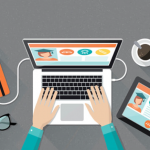
Guiding Question:
How could we or should we use technology in math and science learning environments? How technology might be used to support or enhance learning
Technology Image (Flickr)
My starting perspective about what “counts” as good use of technology in math and science learning environments.
- Tools that are available for student use in their lives (or maybe future circumstances, such as work)
- Tools for communication (gather and share ideas with others)
- Tools that can be used to produce shared knowledge or some product (build common work)
- Tools that improve efficiency and effectiveness (faster and less tedious, provides a clearer method)
- Tools that build enthusiasm and interest (allows personalization and differentiation in teaching/learning)
- Tools that reinforce or generate learning in new contexts (in-situ learning, real-life applications, inquiry based)
- Tools that increase accessibility and different learning styles (supports reading and writing with read aloud or dictation, can be enlarged to improve visibility, uses student friendly language, and adheres to set quality standards)

My brainstorm of what I consider ‘good uses’ of technology is focused on technology that supports teachers and learners with in a variety of ways. Certainly, curricular objectives need to be a central aspect, allowing learners to better explore and understand concepts, while also developing higher order thinking skills as outlined in Bloom’s Taxonomy: application, analysis, and critical and creative thinking (Armstrong, 2010).
In addition, ‘good use’ of technology aligns with and supports 21st century learning skills (Alberta Education, 2023) in the process, including, for examples, fostering self-reflection, creating technical productions, establishing inclusivity, and adopting assistive technology (Thiel, 2018). Classrooms need to be equipped with modern technology and teachers need to be trained, not only with the operation of the technology, but how to integrate the technology into their classroom practices as part of their pedagogical tool kit, effectively building learning not only for the present, but also for the future.

21st Century Competencies (Alberta Education, 2023)
References
Alberta Government. (2023). Competencies Overview. Alberta Education. Retrieved January 19, 2022 from https://education.alberta.ca/competencies/student-competencies/
Armstrong, P. (2010). Bloom’s Taxonomy. Vanderbilt University Center for Teaching. Retrieved January 19, 2022 from https://cft.vanderbilt.edu/guides-sub-pages/blooms-taxonomy/
Thiel, L. (2018). Professional learning design framework: Supporting technology integration in Alberta. Research in Learning Technology, 26. https://doi.org/10.25304/rlt.v26.1989
